
MALT
MALT SPROUTS
MALT EXTRACTS
FUME SWEETWORT
HORAL HOME-MADE BEER
SLADOVNA, spol. s r.o.
Karolíny Světlé 1488/4
792 01 Bruntál
Czech Republic
Tel.: +420 554 712 874
sladovnabruntal@email.cz
MALT
Malting of barley - manufacturing process
Malt is one of the main base materials for beer production. Its quality is vital to the technological process of beer production with fundamental importance for attainment of required chemical structure, organoleptic features and colloidal stability of this drink.
Production is provided in five principal industrial processes:
- Reception and storage of barleycorn
- Soaking of barleycorn
- Germination of barleycorn
- Drying and kilning of green malt
- Preparation of dried malt, storage and expedition
Of primary importance for production of quality malt is the use of first-class malting barley. It depends not only on which malt variety is used, but also upon the uniformity and maturity of the corns.
The production programme itself starts with barley soaking, which helps to wash the barley grains as well as activates vital processes in them. The aim of soaking is to increase the constitutional water content, which is essential for vital potential of the grain, and to reach the vegetation water content necessary for germinating and enzymatic reaction progressing. Germinating of barley is not initiated until a certain water content is reached:
- 8 – 10 % - constitutional water necessary for vitality of the grain
- 30 % - acceleration of vital processes
- 38 % - the quickest sprouting
- 40 – 48 % - endosperm dissolves, enzyme synthesis and activation
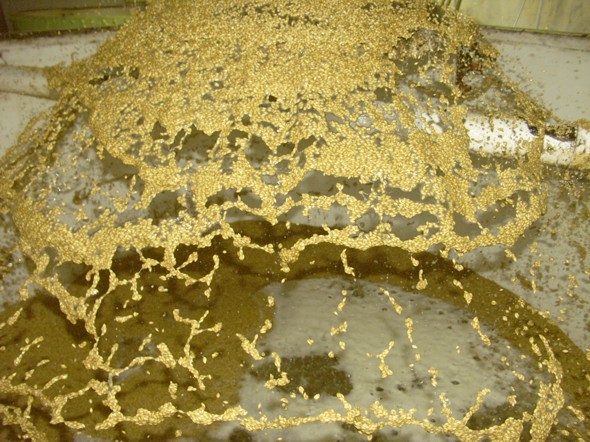
Individual parts of the grain imbibe water in different ways. As for the time, the quickest absorption occurs in the first 4 to 8 hours of soaking. The water uptake depends on the temperature of water used for soaking (the warmer the water, the quicker the absorption), on grain characteristics (its size, purity, refine degree, swelling capacity) and on the technology of soaking. However, the soaking is not mere watering of the grains and waiting for the required hydration level. The water has to be changed several times as products of the initiated grain metabolism are released in water and, at the same time, oxygen is being exhausted. In practice, grains are repumped many times between several soaking tanks. There is always some dirt in the first steeping water and glumes, dust and lighter grains wash out. After being dried, this waste product makes forage for animals. The whole soaking process takes about 48 hours in our establishment. As soon as 45% water content is reached in grains, another production stage follows – germinating of the barley on malting floors.
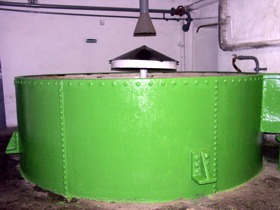
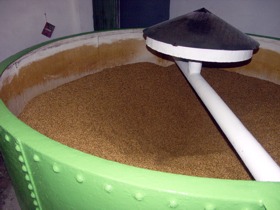
The aim of malt germinating is activation of the enzymatic system in grains, synthesis of enzymes and reaching the required modification according to the type of the produced malt at limited vegetation. Germinating is a physiological process during which germs of rootlets (chits) and leaves evolve in the germinal part of the grain using the reserves of endosperm. For optimal sprouting, grains need a sufficient amount of water (44 to 48 % of water), optimal temperature (14 – 18 °C) and sufficient oxygen supply. The energy needed is provided by breathing. The burnt material is mainly starch. Germinating proceeds in malting floors – spacious rooms for classic germinating procedure. The floor is made from concrete flatwork or tiles. The malting floors have to be aerated efficiently; the temperature during the year should be constant at around 10 °C, at the most 15 °C. There is also high air humidity from 85 – 95 % and windows should only transmit dim light. By means of mechanization the barley is spread out on the floor into a layer 10 – 14 cm (in practice, the thickness of the layer is adjusted according to the temperature in the malting floors). To ensure constant germination, the barley layer needs to be turned mechanically. A long rootlet grows on the corn on the third or fourth day and the most important stage of germination begins – "the youth stage". At this stage, breathing is most intensive and enzymatic changes, called modification (enucleation) of the grain, are initiated. This is followed by the "heap aging stage" during which the layer of the barley is aerated, thus preventing mutual root entangling. The "old wilted heap" is the final stage in the seventh day of germination. A "green malt" is obtained and transferred for kilning.
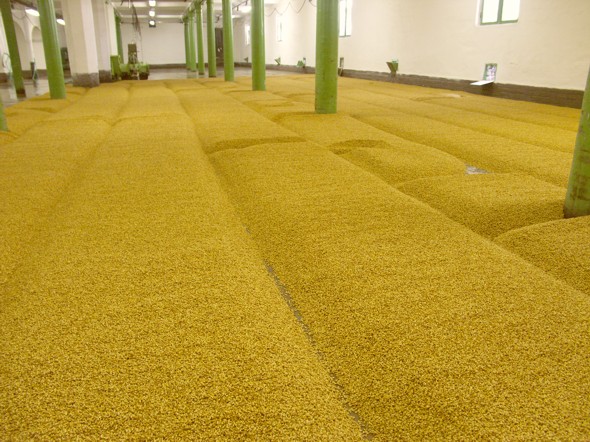
The aim of kilning is to reduce the water content to 4 or even 5 % in light malts, to stop vegetation processes, to partially reduce some enzymatic activities and to establish gustatory, colour and oxidoreduction agents. The green malt has a high content of water and is not storable. An appropriate temperature treatment is needed to stop the enzymatic activities and even partially inactivate certain enzyme groups and to ensure conditions for reactions creating gustatory and coloured substances. During drying and kilning, the optimal characteristics of malt are ensured by relations between the increasing temperature and decreasing water content in the grain. Malt drying and kilning proceeds in three phases. In the first stage, which is called the growth stage, the grains are able to keep on germinating, their water content being more than 20 % with the kiln temperatures not exceeding 40 °C. Then the "enzymatic stage" follows, during which the water content drops below 20 %, the kiln temperatures rise between 40 up to 60 °C, which results in suppressing of the vegetation process but not enzymatic reactions. For the third stage – the so-called "chemical reaction" – the water content below 10 % and kiln temperatures exceeding 60 °C are characteristic, making the enzymatic reactions stop. The chemical reactions are still active, though, creating coloured and gustatory substances.
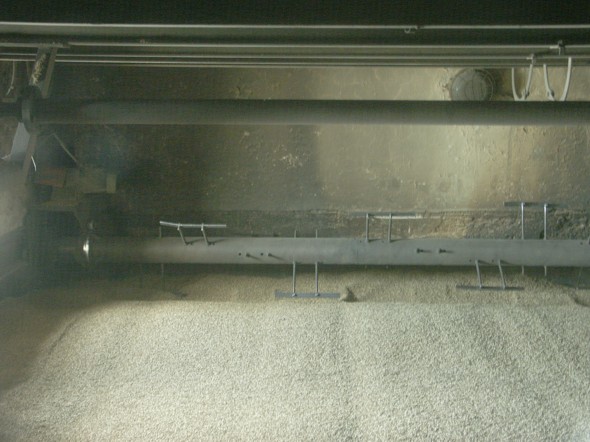
After the kilning of the malt the dry rootlets and overgrown acrospires are known as malt sprouts. They are separated from the malt grains in a malt screener; they also partially crumble during the kilning and fall through under the hurdle.
The last task is to ensure the correct storage of the malt and to prepare it for the dispatch to customers.